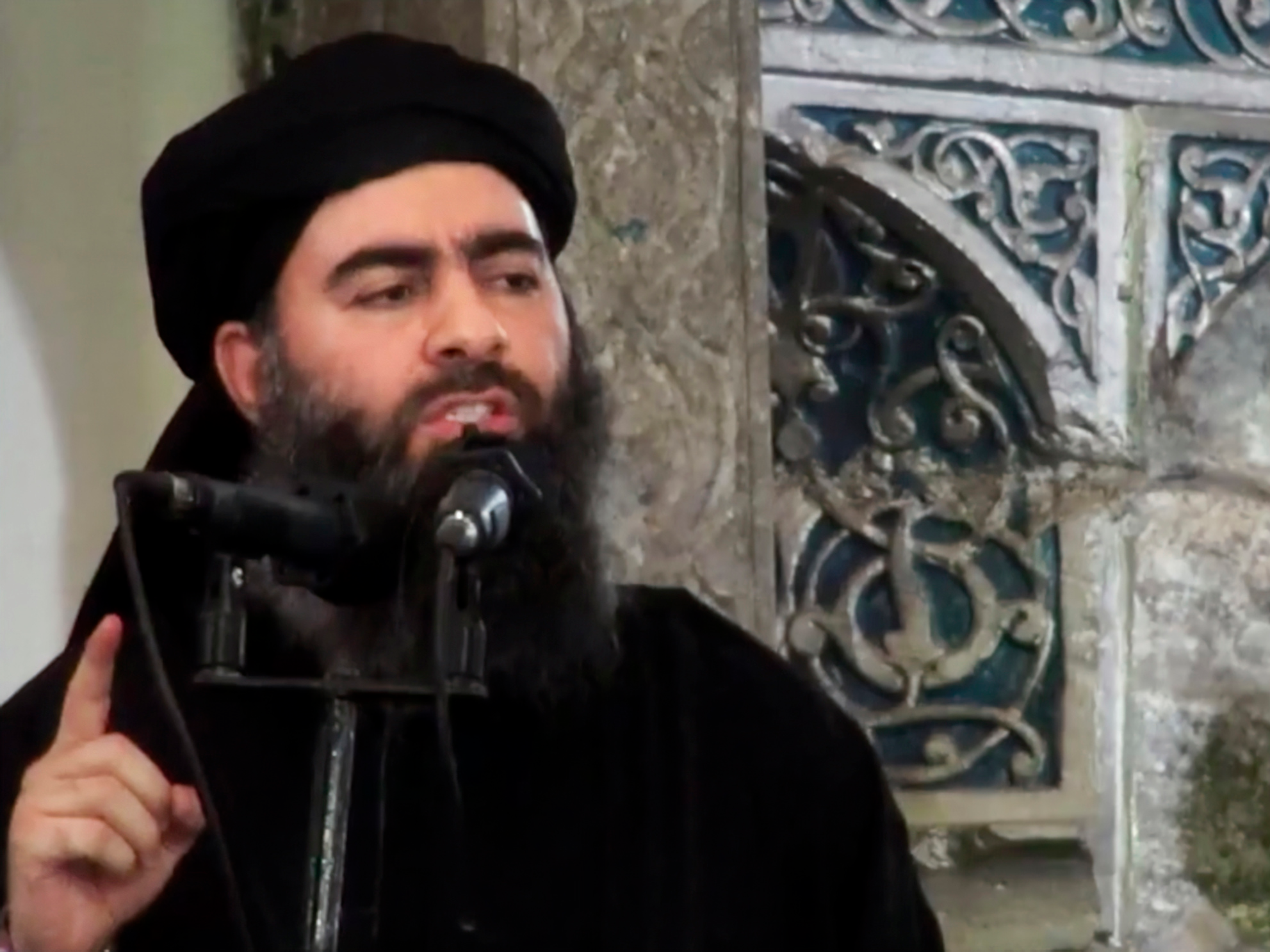- Abu Bakr al-Baghdadi, who led the Islamic State terrorist group to kill and enslave thousands and to seize territory in Iraq and Syria the size of Great Britain, was killed in an early-morning raid on Sunday.
- Informants within Syria found one of al-Baghdadi’s top aides at a market in Idlib and followed him to the house where Baghdadi was staying.
- Army Rangers and Delta Force operators flew on eight helicopters from Iraq to the compound, where they were met with small-arms fire upon landing.
- Al-Baghdadi was killed and the mission was complete by 7:15 p.m. ET on Saturday.
- Visit Business Insider’s home page for more stories.
Abu Bakr al-Baghdadi, the leader of the Islamic State terrorist group, was killed in a US operation in Syria early Sunday morning local time.
US, Iraqi, Turkish, and Kurdish intelligence, working with informants close to al-Baghdadi, were able to discover where the terrorist leader was hiding out.
Under al-Baghdadi, the Islamic State, also known as ISIS, ISIL, or Daesh, killed and enslaved thousands of people and held territory in Iraq and Syria from 2014 to 2019 that at its peak was the size of Great Britain.
The operation to capture or kill al-Baghdadi was named for an American aid worker, Kayla Mueller, who was captured by ISIS in Syria and later killed.
Details of the operation continue to emerge. Al-Baghdadi is said to have detonated a suicide vest as he hid in a tunnel in his compound, killing himself and three children who were with him near Idlib, Syria.
Read on to learn more about what we know of the raid that killed al-Baghdadi.
Iraqi intelligence got a break in February 2018 that led to the raid, Reuters reports.

Ismael al-Ethawi, a top aide to al-Baghdadi, told Iraqi intelligence that the ISIS leader would conduct strategy meetings in buses filled with vegetables to avoid detection, Reuters first reported.
After he was captured by Turkish authorities, al-Ethawi also told Iraqi intelligence about some of the locations in Syria that al-Baghdadi was using to meet with trusted aides, including al-Ethawi.
"Ethawi gave valuable information which helped the Iraqi multi-security agencies team complete the missing pieces of the puzzle of Baghdadi's movements and places he used to hide," an Iraqi security official told Reuters.
Ethawi is in jail in Iraq and has been given the death sentence, according to The New York Times' obituary of al-Baghdadi.
A disillusioned ISIS member provided information to Kurdish-led forces on al-Baghdadi's whereabouts.

Mazloum Abdi, the leader of the Kurdish-led Syrian Democratic Forces, has said his forces began gathering intelligence on al-Baghdadi's whereabouts five months ago, according to The Washington Post.
In mid-2019, Reuters reports, Iraqi, US, and Turkish intelligence officials were able to nail down the northwestern Idlib province as the location of al-Baghdadi's hideout after capturing five senior ISIS leaders who told them locations where they were meeting al-Baghdadi.
Informants within Syria then found al-Ethawi at a market in Idlib and followed him to the house where al-Baghdadi was staying.
"We passed the details to the CIA and they used a satellite and drones to watch the location for the past five months," an Iraqi security official said.
Intelligence from Hayat Tahrir al-Sham, a former affiliate of Al Qaeda that controls the area surrounding Idlib, may have aided in al-Baghdadi's capture, too, Reuters reports.
A jihadi commander in Idlib said HTS had captured Abu Suleiman al-Khalidi, a close aide to al-Baghdadi. HTS is believed to work with Turkish forces in northwestern Syria; information from al-Khalidi may have been passed on to other intelligence agencies.
About the same time, The Washington Post reports, a disaffected ISIS member began to leak information to the SDF; as the US became more confident in the informant's credibility and put his intelligence together with additional information they had uncovered, the plot to capture or kill al-Baghdadi came together.
According to President Donald Trump, the operation to capture or kill al-Baghdadi at his compound in Idlib began two weeks ago, once US forces had the ISIS leader "scoped."

Vice President Mike Pence, speaking on CBS' "Face the Nation," said that US officials received intelligence about al-Baghdadi's whereabouts early last week and that on Thursday afternoon officials "were informed that there was a high probability he would be at the compound in Idlib province."
On Friday, military officials provided Trump with different plans to go after al-Baghdadi, Pence said. That same day, according to Reuters, al-Baghdadi and his family left their compound by minibus, for the last time - perhaps the "actionable intelligence" Pence mentioned that allowed US forces to embark on the Saturday operation.
The raid on al-Baghdadi's compound began in the early hours of Sunday morning local time, The Washington Post reports.

Details are beginning to emerge about the operation:
- The operation was code-named for Kayla Mueller, the American aid worker who was captured by ISIS and repeatedly raped by al-Baghdadi before she was killed. Mueller was abducted from Aleppo in 2013 and confirmed dead in 2015, though her body has not been recovered, CNN reports.
- Troops involved in the operation, including some members of the Army's Delta Force, took off in eight helicopters out of Iraq early Sunday morning local time - Saturday afternoon in Washington, DC.
- The troops were met with small-arms fire upon landing in Syria, just a few miles from the Turkish border.
- The commandos involved in the operation called out to al-Baghdadi once they arrived at the compound to see whether he would come out. They breached two walls of the compound with explosives, fearing the entrance was booby-trapped, after 11 children and a few adults emerged, according to The Washington Post.
- Al-Baghdadi didn't emerge, instead retreating into the tunnels of the compound with three children. A dog working with US forces followed al-Baghdadi into the tunnel, where the terrorist leader detonated a suicide vest that killed himself and the children.
- US forces performed a DNA test on al-Baghdadi's remains in a secure location, Gen. Mark Milley, the chairman of the Joint Chiefs of Staff, said in a press conference Monday.
- The compound was destroyed by US firepower, including Hellfire missiles, Joint Air-to-Surface Standoff Missiles, and GBU laser-guided bombs, according to Milley.
Trump announced Sunday morning that al-Baghdadi had been killed by US forces.

Trump sat down in the White House Situation Room to watch the raid at about 5 p.m. ET on Saturday, The New York Times reported.
Trump, Pence, Secretary of Defense Mark Esper, the national security adviser, Robert O'Brien, and other members of the national security team watched the raid unfold via overhead surveillance footage. No sound is available on such footage to prevent interference from the Situation Room during these operations, The New Times said.
While the troops involved in the raid were wearing body cameras, that footage was not relayed to the Situation Room in real time, as it contains disturbing images and can be disorienting. As The Times reported, that footage is meant to be viewed after the fact.
Trump described al-Baghdadi as "screaming, crying, and whimpering" when he died, though it's unclear how he obtained that information; he may have talked to those directly involved.
The mission was complete and al-Baghdadi dead by 7:15 p.m. ET on Saturday, O'Brien said on NBC's "Meet the Press" on Sunday.
In the aftermath of the operation, it's unclear what's next. Here's what we know, and what we don't.

- The dog who followed al-Baghdadi into the tunnel was wounded in the operation but is recovering, though his name has not been released.
- It's unknown where, how, or whether al-Baghdadi's remains were buried; Milley told reporters that the remains were disposed of "appropriately," and according to one report they were buried at sea. Navy SEALs buried the remains of the Qaeda leader Osama bin Laden at sea after the 2011 raid in Pakistan that killed him.
- Two men who were taken from the compound are in US custody, Milley told reporters during a press conference Monday afternoon.
- Abu Hassan al-Muhajir, a spokesman for ISIS and a likely successor to Baghdadi, was reported killed in Syria on Sunday in a separate operation, though US officials have not confirmed the operation, which is believed to have been a joint effort between US and SDF forces, The New York Times reports.

